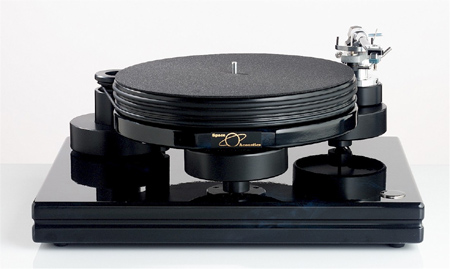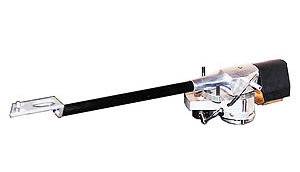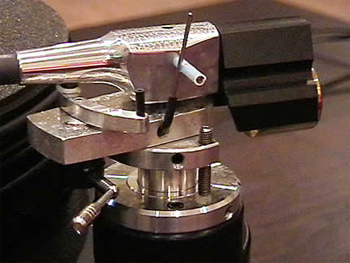You are reading the older HTML site
Positive Feedback ISSUE
19
may/june 2005
nottingham
Space Deck turntable and ACE Space arm
as reviewed by Larry Cox

|
LARRY COX'S SYSTEM LOUDSPEAKERS ELECTRONICS SOURCE CABLES ACCESSORIES
|
My wife is eight months pregnant, and I'm preparing for a new "component" to enter our house. We've spent a lot of money putting in new wood floors and five double-paned picture-sized windows. I've painted two rooms and have two more to go. As my home life piles on more things for me to do, I'm excited about the prospects, but with poor time management, I have gobs of PFO reviews to write before I hibernate for a while.
Fortunately, writing about the Nottingham Space Deck and ACE Space arm is straightforward. Many designs fail to live up to the designer's claims, but not these. Nottingham's chief designer, Tom Fletcher, does not rely on esoteric claims of refuting the laws of physics. His designs are the result of thirty years of ongoing refinement of an already complete design. About twenty years before the appearance of other plinth-less turntables, Nottingham was dancing to the rhythm of its own drummer.
The Space Deck and ACE Space arm retail for $2999 as a pair. Buy them separately and you're three hundred bones more in debt, as the Space Deck retails for $1799 and the arm for $1499. Although their fit and finish are very good, the styling is very bare bones. The table is a demonstration of Einstein's principle: Make things as simple as possible and no simpler. It comes in all the colors of Henry Ford's Model-T rainbow, namely black. There are three legs, two of which you can raise or lower to level the table. The third leg is fixed. I moved the table several times due to home improvements, and since our floor isn't flat, each move required re-leveling the table. Fortunately, the design makes leveling the table easy. There's room for two arms, but the Space Deck I received was ready for just one. Mounting a second amounts to adding another arm platform and moving the motor from its ten o'clock position to seven o'clock. Nifty.
The Space Deck is provided with a base that the table sits on. The platform was an afterthought to appease the Japanese, who cried out for a square turntable. Fletcher says that the platform is not necessary. I found that it provided worthwhile damping, but maybe I just made that up. The platform on the review table was blue/black, but it sis also available in black.
Speaking of simplicity, there's no start button on Nottingham tables. The motor is only powerful enough to keep the record spinning, so you have to start the platter yourself. Ditto for stopping it. Fletcher opines that if the motor were powerful enough to start and stop the platter, cogging would be audible. That could be. I can't say I've heard cogging with other belt-drive designs, but maybe that's just my ears.
The bearing is not brass but admiralty bronze, originally designed for cannons. The bearing is said to have an affinity for the hardened steel of spindles, thus making it a good match for spinning records. The sonic improvement is apparently worthwhile.
Some manufacturers tout silk threads, others other materials. Nottingham has a club of its own—the silicone belt club. The silicone is intended to stop motor vibration from passing into the platter. Nottingham's maintenance suggestion for the belt is to remove it every five years, bunch it up into a ball, wash it in the sink, rinse it off, let it dry, and put it back to work. The belts last about fifteen years.
Finally, the Space Deck's platter is an alloy of metal and non-metals, and has a damping ring around the periphery. The proprietary mix of materials is said to further damp vibration from the system.

Continuing with the simpler-is-better motif, the ACE Space arm is a mechanically damped unipivot. The arm tube is made of carbon fiber. Like all unipivots, the ACE Space has tons of pressure per square inch at the pivot. If I understand this correctly, the mechanical damping results from using two hardened steel stabilizing bars as close to the center pivot as possible. The bars are in contact with a precision miniature roller bearing that is fixed to the hardened steel unipivot shaft. Resonance from the bearing shaft is dissipated into the bars. Unlike other carbon fiber designs, the grain of the fiber in the ACE Space arm runs the length of the arm rather than around the diameter. This, Nottingham's importers say, gives it better resonance control and rigidity. Also, there is a second carbon fiber arm tube inside the first arm tube, but with a smaller grain structure.
Arm height is adjusted by a threaded bolt. You can adjust VTA on the fly, which is very desirable. It is almost as easy as to use as it is to describe. There is no finger support for cuing records at the headshell. Tom Fletcher insists not only that there is there no need for it, but that there are reasons for not having it. Cuing aids act like tuning forks, and can add energy/vibration at the cartridge, where they are least desired. Once you've slid the arm across to position the cartridge, just flip the cuing lever, and the needle drops precisely into place. I found the arm to be the very best for accurate cuing. However small a victory that is, I loved it.

At the back of the arm is a plastic collar that holds a brass ring. The ring acts as the counterweight. Tracking force is adjusted by sliding the brass ring closer to or further away from the pivot point.
The arm and table come with setup instructions. Ha ha ha ha ha! It is shameful to call these instructions. If you don't understand how to set up a turntable, they will be very unlikely to provide any insight into how to do so. I inadvertently tried to remove the anti-skating device because the instructions made no mention that the bar is part of the arm! Foolish me—I thought it was a transit protection device. I spoke with Tom Fletcher about the instructions at CES, and he admitted that they were inadequate, but offered no promise that he would update them. Nottingham's importers say that the turntable should be set up by a trained dealer. Perhaps that's reasonable, but one of the joys and pains of analog is maintaining a table's performance. With inadequate instructions, users will be guessing what to do, and that can't help matters.
That said, this table is blazingly easy to set up. It is so simple that I was done before I knew it. I literally looked around thinking that I must have missed some adjustment. If you've ever set up a turntable and arm, this one will be a breeze. Only the anti-skating feature confused me. Simple instructions on this would be welcome. Even though it's a small quibble, it seems inappropriate not to go the extra inch to finish the job.
When I first started playing with the Space Deck, it made me a little nervous to start and stop the table with my fingers. I thought I was going to wear the motor out, but apparently there have been no motor failures in Nottingham's nearly thirty-year history, so the wear and tear of normal use apparently doesn't do much wearing or tearing.
In operation the arm isn't as skittish as other unipivots I've tried. VPI's JMW arm sounded a bit nervous in my bouncy living room, but it wasn't until I heard the RS Labs unipivot that the JMW arm's nervousness became apparent. I expect that my bouncy subfloor can excite some unipivots. I experienced no such issues with the ACE Space. It sounded excellent, even in a bouncy environment. It did not sound skittish. It sounded more continuous and less nervous than the JMW, though perhaps less stalwart than the SA-1. The SA-1 is quite heavy, and utilizes its mass to maintain its position rather than needing to be bolted to a turntable. I expect that its excellent resolution can be attributed to its weight. The ACE Space, despite its lighter weight, was no slouch either. It's a brilliant implementation that allows for excellent results.
At first, I found that if I didn't spin the table fast enough, the record turned too slowly, which dramatically altered the pitch of the music. That was a little disturbing, and I thought that the Space Deck's low motor torque was the culprit. However, the antidote for too slow a rotation is to give the platter a good strong spin. Within a revolution or two, the record will slow to the correct speed. After a while, I found it easy to get the table to spin at the correct speed, and thereafter the Space Deck maintained speed and pitch stability.
What's to like about the Nottingham Analogue Space Deck and ACE Space arm? For starters, there's the simplicity of the table. The materials chosen are quite robust, which buy you a turntable that'll last you into your dotage. If you're looking to step off the upgrade merry-go-round and stay off, this turntable can do it. However, it isn't a piece of audio jewelry. If you want a pretty turntable, its looks aren't likely to put it on your list. What you see is a simple turntable and what you get is just that.
The fact that it's simple doesn't by any means say that it's cheap, ineffective at delivering the musical goods, or worth your money. It just means that the happy purchasers of this table are ones that want a turntable that works well, and isn't a statement of affluence. It is, though, a statement of a commitment to good analog. It seems to say, "I'm here to deliver the goods, and I'm not getting dressed up for you. Love me for what I do, and don't hold it against me that I don't look like the latest audio hottie."
If the VTA is off, you'll know it, quickly. With all of the stuff going on for me right now, I'm not eager to tweak, yet I found myself making fine adjustments to the VTA. In part, that's because small adjustments resulted in large alterations to the sound, and in part it was because making those adjustments was quite easy. Adjusting VTA is rewarded with increased clarity, imaging, and better tone. At a tariff of thirty seconds of adjustment time, it's quite affordable.
I found myself, much to my consternation, changing arm height for different records. Willie Nelson's Stardust was an excellent first listening choice. The original issue is flimsy, and required me dropping the height of the arm for better sound. It's a record I've scoffed at before, but I found it to be excellent. Willie's wan, pinched, and nasal voice had an authenticity with the Nottingham. My Koetsu Rosewood in combination with the Nottingham pair, provided for a lovely, intimate experience. It wasn't just Willie sharing his craft, but opening his heart. The Nottingham's reproduction of Stardust is the stuff that makes people audiophiles. Imaging was excellent, with plenty of space for instruments. Other such records were similarly well treated. When presented with a good recording, the result was good sound, but give this pair a poor recording, and guess what? Poor sound.
I pulled out Sir Adrian Boult's rendering of Elgar's Falstaff Symphonic Study. Elgar riffing on Bach is a mighty good combination, on a much larger scale than Stardust. The intimacy of Stardust was repeated and then some on the "Sanguine Fan" piece, but also blossomed to include the larger scale of Elgar's transcription of Bach's Fantasia. Delicacy, warmth, and detail swept the room with beauty. Well, almost—Mobile Fidelity's 180-gram recording asked for a different arm height. Ahhhh, that's it. Just a little tweaking made a big difference in imaging and detail retrieval, as well as in musical satisfaction. Koetsus aren't detail detectives, yet the Nottingham pair allowed mine to render lots of detail.
Stardust was a bit small and Elgar a bit larger than the perfect fit for the Nottingham pair in my system, but female vocals with a small backing orchestra was just right. Linda Ronstadt's What's New was magically rendered, with all the weight, size, dynamics, and space that my system could deliver. An added dose of female pheromones and the sweetness and beauty of Ronstadt's voice provided another kind of stardust. The Nottingham combination allowed the beauty in the grooves to light up the stage between my speakers. Although not quite as sweet as the sweetest rendering I've heard (that distinction belongs to a much more expensive system I heard at a Stereophile show about fifteen years ago), it was among the very best I've heard at my house. Ditto for an original pressing of Emmylou Harris' Profiles. Instead of the grand, lush sound of What's New, Profiles delivered a more fragile, higher-pitched dab of female beauty.
At least in my current system, the Space Deck and ACE Space arm didn't provide the wallop that I got from my SOTA Sapphire. Bass was not absent, but the room didn't rock in places where I wanted it to "party." For instance, "Jamie's Crying," from Van Halen's debut album, didn't have the bottom end oomph that makes that track a silly delight. Ditto for the few parts of Elgar's "Sanguine Fan" that contain deep bass drum strikes. The bass was there, and was satisfying, but I had a sense that a bit of depth and bloom was missing. Nevertheless, I preferred the Space Deck's slight excess of control to an overweight, undercontrolled bottom end. I can't say whether the problem lay with the Space Deck or with my new Ensemble Figura speakers. I didn't have my ATCs while the Space Deck was with me, and they certainly plumb more deeply than the Figuras.
I also pulled out The Clash's London Calling, Steve Forbert's Alive on Arrival, The Doobie Brother's Living on the Fault Line, and lots of other late-70s/early-80s LPs. With the leaner, hashier-sounding LPs, the Nottingham pairing didn't pull punches, nor did it take withered recordings back to the musical vine. Ya gets ‘em like they is, mostly.
The Nottingham Space Deck and ACE Space arm gave fast, nimble, detailed sound. I'd say the combo is a hair toward the analytical, but barely so. Its overall character was as close to neutral as I've heard, certainly not sweet or romantic, though when recordings like What's New were playing, the sound could be romantic, even lovely. The sound was not overtly rhythmic, but rhythm could get air time if it was on the source material. The turntable was nimble enough to allow you to divine the rhythm of the performance, but not like, say, a Naim product, which nearly always announces the rhythm. I think that that quality of Naim gear is a coloration, however pleasant or desirable, while the Space Deck is going to be among the more neutral pieces in most systems.
Some reviewers of the previous Space Deck and ACE Space arm noted its exceptional imaging. I agree with that assessment, although I've heard it bettered by more expensive turntables. Since I'm just not an imaging slave, it's just not something I value.
Do I recommend the Space Deck? Absolutely, given its solid performance and ease of operation. The ACE Space arm is particularly delightful, given the ease with which VTA can be adjusted. For the money, this pair is certainly worth a spin. Larry Cox
Space Deck with Ace-Space
Arm
Retail: $2999
Space Deck without arm
Retail: $1799
Ace-Space Arm
Retail: $1499
Nottingham
web address:
www.aslgroup.com
